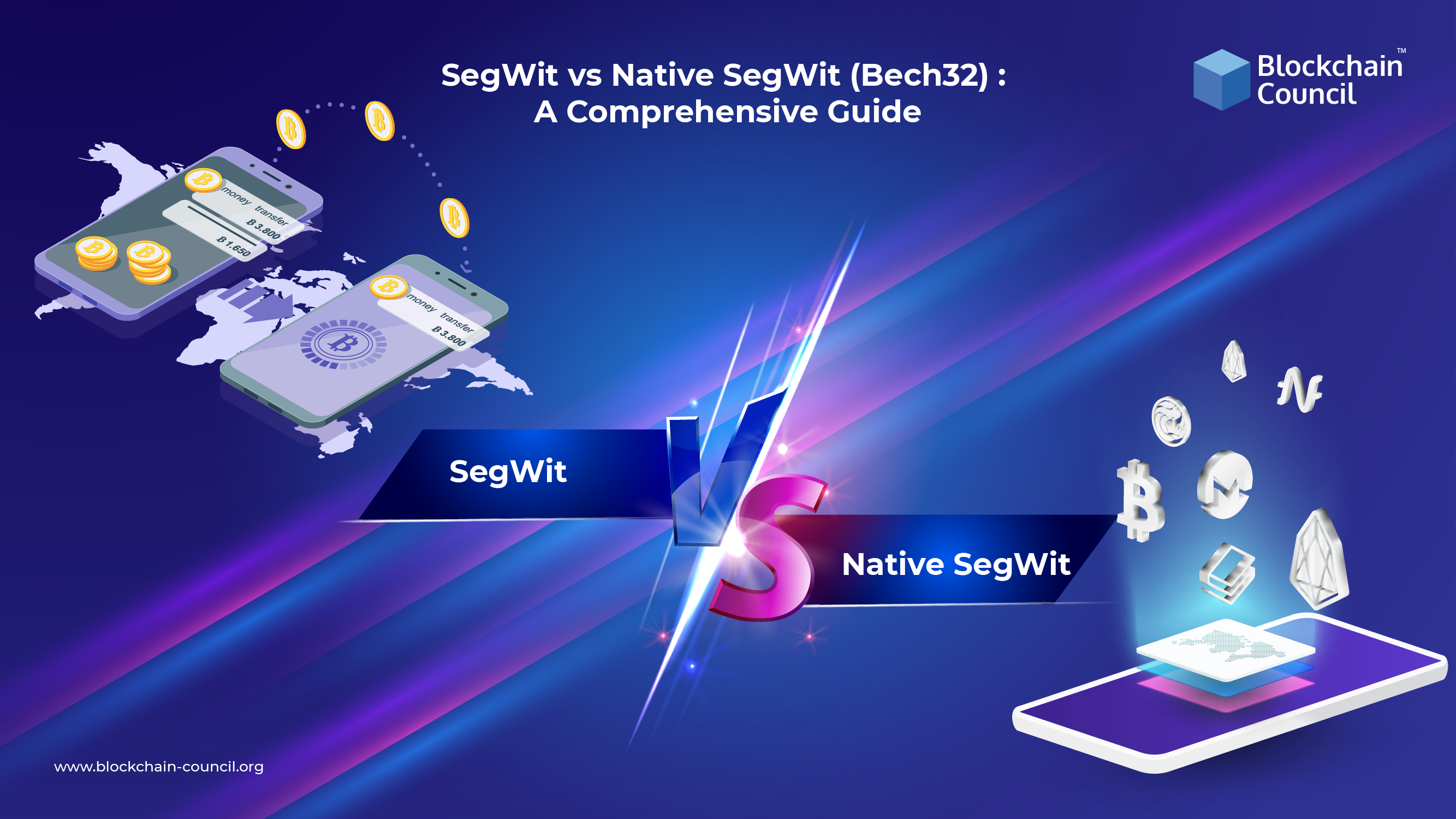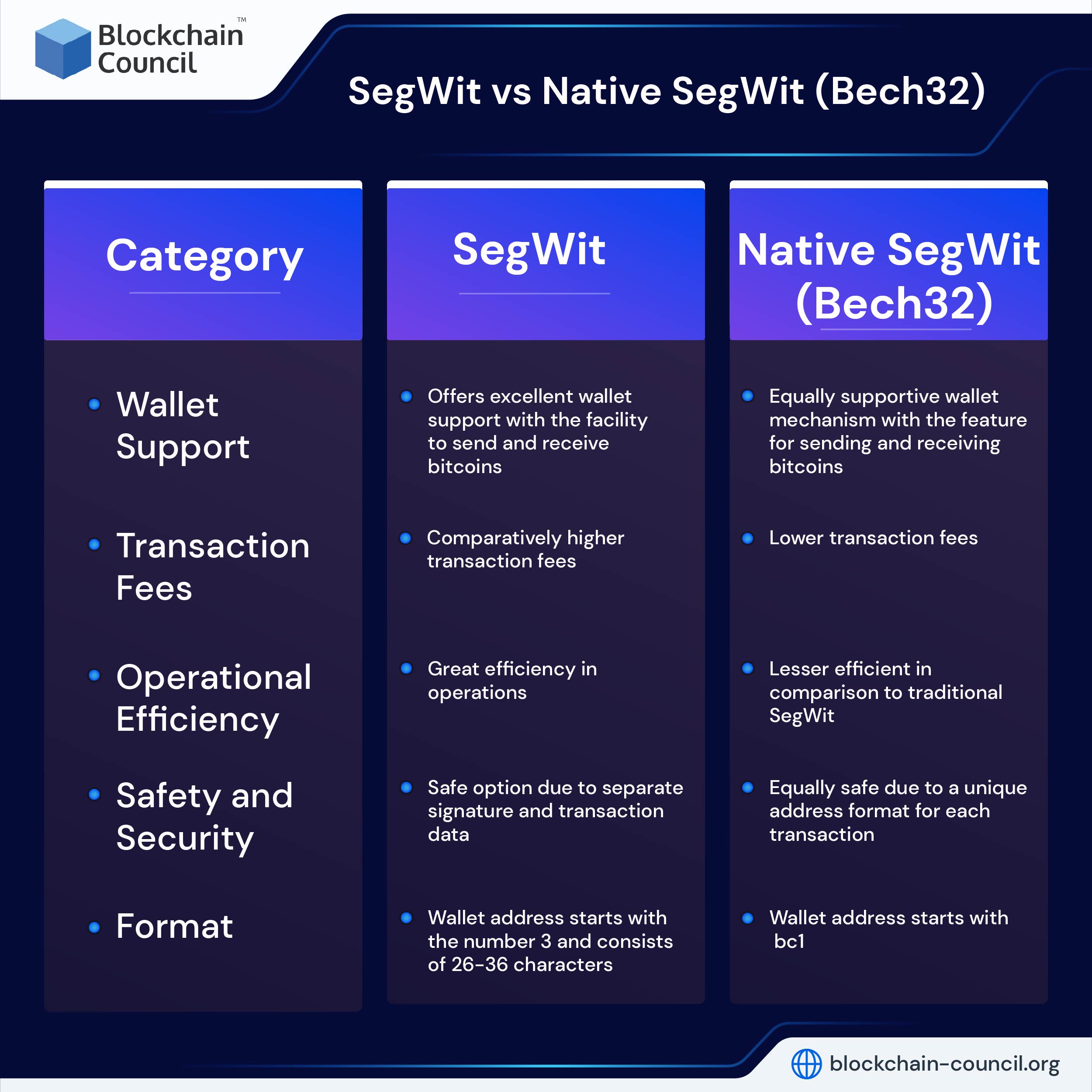
- Ayushi Abrol
- September 08, 2022
Before proceeding with our debate of SegWit vs Native SegWit (Bech32), let us learn about the fundamentals of segregated witness address, abbreviated as SegWit and native segregated witness address, better known as Bech32 or Native SegWit.
While adding a Bitcoin account, a ledger user is usually presented with two options in the beginning. The first is a Native SegWit and the second one is SegWit. However, there are certain differences between the two address formats.
In this detailed blog, we will take you through a comprehensive guide discussing the two terms in detail while understanding the fundamental difference between them.
What is SegWit?
In our discussion of SegWit vs Native SegWit (Bech32), let us take a start with the conceptual meaning of SegWit. The total digital signatures constitute almost 65% of the total space on the blockchain. This situation is for any given transaction on the blockchain. A segregated witness address essentially facilitates a reduction in the consumption of space by managing the data of a given signature. It also transfers the signatures from the input structure to the final stage of the transaction.
How does SegWit work?
The working mechanism of a segregated witness address (SegWit) starts with –
- A transaction that contains the wallet address of the sender and the receiver.
- The second part of the transaction contains data and signatures. The segregated witness address removes and isolates the data from the main block which reduces the overall transaction size. This is how transactions consequently need less space which enhances the scope for more transactions for each block.
- Once this process is done, the segregated witness address fixes the remaining flaws in the Bitcoin protocol that enables the user to alter the transaction hashes. When there is a change in a single character, there is a corresponding change in the rest of the transaction hashes.
- As soon as the signatures are removed from the transaction data, there are no more changes needed in the existing transaction ID.
What advantages does it offer?
Segregated witness addresses come with a lot of advantages for the users.
- Firstly, it is a simple and effective solution to most of the problems in the Bitcoin protocol, including transactional fees and inefficiency in operations.
- Secondly, segregated witness addresses allow the user to perform more transactions without influencing the overall Bitcoin blockchain size in general.
- The user gets to transact Bitcoins at a cheaper rate which is the result of higher transaction speed.
- In addition to this, there is always a good scope of new and exciting developments in its arena. This is because Bitcoin is one of the cryptocurrencies used by the masses due to its popularity.
- At the same time, a lot of users face issues with the problem of scalability. This is exactly what segregated witness addresses help with.
What are the complications involved?
While several advantages come with segregated witness addresses, it also suffers from various complications that a user needs to be aware of.
Firstly, it does not allow the miners to generate great profits as the support system includes witness data side chain, which hinders the scope for generating fees revenue.
Secondly, this particular protocol fails to go far enough to address the issue of scalability; this makes it a short-term solution to long-term issues. Several Bitcoin miners agree that there are major changes to the Bitcoin blockchain size but how transactions are processed is equally problematic in the long run.
In addition to this, it can cause possible divisions in the entire Bitcoin community due to the ongoing disagreements surrounding its usage.
What is Native SegWit?
Native Segregated Witness Address (Bech32) that is equally compatible with segregated witness address (SegWit). The address strings in Bech32 always start with bc1, which gives it a distinct format.
Initially, the developers implemented it as a part of the Bitcoin improvement proposal but then various addresses were integrated alongside the core ones. Coming to its format and structure, it has changed a lot since its initial developments. It now uses mixed case lettering because the initial addresses are difficult to type and are often vulnerable to input errors during transactions.
What is its working mechanism?
The working mechanism of native segregated witness addresses is quite similar but at the same time different from SegWit.
As soon as a transaction is initiated from the end of the sender, the involved codes and transaction data are stored on the database and immediately transferred to the end of the sender. The involved script code and characters are recorded on a separate extended block. Hence, the decentralized structure provides enough safety and security for both ends. As soon as the transaction is completed and the Bitcoins are transferred to the target wallet, the data is recorded and shared with the server.
What benefits does it offer to the users?
- In comparison to other segregated witness addresses, Bech32 has a comparatively lower transaction fee.
- It gives the user a better experience on the blockchain platform.
- There is also a lesser chance of errors while sending and receiving Bitcoins through native segregated witness addresses.
- In addition to this, with Bech32 addresses, the user can also identify the characters involved in their transaction that are likely to be incorrect. Hence, the user experiences a safe and secure transaction experience without any hassle on the blockchain.
Are there any disadvantages?
One of the biggest disadvantages of native segregated witness addresses is that it is not completely compatible with the old software. This is also the reason why the users are not able to get messages verified in every software. In addition to this, minors are usually not able to generate great profits as there is a lower transaction fee included in the transactions.
SegWit vs Native SegWit
Now that we are aware of what the two terms mean, let us now proceed with our discussion of SegWit vs Native SegWit (Bech32) and reflect on the differences between the two. When it comes to comparing the two types of Bitcoin address formats, it is essential to consider various factors and then see what works better with one and fails in the case of the other.
Although both SegWit and Native SegWit present a plethora of features to the user, there are several differences between them. The mechanism behind transactions is quite different in segregated witness addresses and legacy addresses.
Here are some other differences that give one an edge over the other –
Wallet support
One of the biggest differences between SegWit and Native SegWit is the wallet support that a user gets. As far as the facility to send and receive Bitcoins is concerned, both Bitcoin address formats enable the user to do so. You can easily send or receive Bitcoins in your wallet using the to address formats.
However, one major difference between the two is that unlike Native, SegWit moves all the data in the Bitcoin block, which keeps signatures of all the transactions together. It allows more and more transactions to take place in the same amount of space while maintaining the security level on the Bitcoin blockchain. It uses different addresses and various third-party wallets to facilitate transactions. Nevertheless, the user needs to check whether the preferred wallet option provider supports all types of address formats or not.
Transaction fees
If there is one ground that forms the basis for the difference between the two, it is the transaction cost involved.
- The user gets several benefits with SegWit as it allows them to send Bitcoins at a lower transaction fee. The fees are lower because it is based on the rate and size of the transaction which reduces the total effective size.
- However, if a user goes for Native SegWit, the overall transaction cost is comparatively lower than the former when sending Bitcoins from a legacy address. In other words, the user gets more benefit with a Native SegWit.
It is also a major reason why many blockchain wallet providers have set their default settings to Native SegWit as the receiving address because a user gets to enjoy a lower fee whenever they receive Bitcoins in their wallet.
In addition to this, it is also essential for the user to know that if they receive Bitcoins previously on the legacy addresses in their wallet, it is likely to remain on the legacy addresses until they send it again. It usually happens because moving the Bitcoin from one wallet to the other increases the overall transaction fees.
Efficiency in operations
Another major point of difference between the two is the scope for efficiency in transactions. SegWit (segregated witness) address formats and provides a much better scope for efficiency than the traditional legacy formats. It happens because the segregated witness addresses enable the separation of signatures every time a transaction takes place concerning the original transactional data. As a result of this separation, any user that uses a segregated witness address pays a lower transaction fee and experiences better efficiency in transactions as compared to legacy addresses.
Apart from this, a user gets to experience faster transactions if it involves a segregated witness address that also comes with an improved capacity of the blocks. It happens because blocks can store data for more transactions with segregated witness addresses when compared to legacy address formats. Segregated witness addresses also present a better scope of formidable improvements in terms of block size, which provides better efficiency to the user as compared to legacy address formats.
Safety and security
In terms of the safety and security of transactions, segregated witness addresses are a far better option as it involves separating signatures from the transaction data. Due to the separation, there is a lot more scope for improved security while transferring Bitcoins from one wallet to the other. Also, it makes it difficult for the hackers to keep track of the transaction signature due to the isolated entities, which is an additional benefit. On the other hand, native segregated witness addresses also present a lot of scope for improvement in safety and security as there is a new address format for each transaction. In a nutshell, the user gets enhanced security features with both options.
Format
The format is another ground that differentiates segregated witness addresses and legacy addresses. Segregated witness address is the most common Bitcoin address format that easily goes with any business or wallet support. It typically starts with the number 3 and consists of 26 to 36 characters. Additionally, it leverages the P2SH script for the basic functions and can also support non-native segregated witness transactions by complying with the recommended cryptographic standards. On the other hand, a Native SegWit presents for beating differences from the general styles, and its format usually starts with bc1.
Who’s the winner?
With reference to the discussion regarding SegWit vs Native SegWit (Bech32), it is safe to say that SegWit is far better in terms of the improvements it has witnessed. It gives a faster transaction speed at low fees with improved scalability. The user gets improved prospects for error detection.
Additionally, the segregated witness address format also enables you to detect any scope for improvement and identify areas where there is better readability by presenting the address in lowercase. Hence, it presents the user with a plethora of benefits over native SegWit.
Final words
On a final note, it is apparent in our debate of SegWit vs Native SegWit (Bech32) that SegWit presents a set of promising features to the user over its competitor. The comparison of these popular Bitcoin address formats along with a deep understanding of their respective significances leaves good scope for differentiating between the two. The differences in their features also represent their revolutionary journey as a solution for issues with the existing legacy address formats. Both the types of address formats help in increasing the efficiency of the block side apart from accommodating the volume of transactions in every block.






































































 Guides
Guides News
News Blockchain
Blockchain Cryptocurrency
& Digital Assets
Cryptocurrency
& Digital Assets Web3
Web3 Metaverse & NFTs
Metaverse & NFTs
